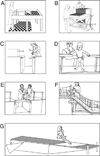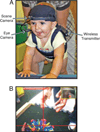The development of motor behavior
- PMID: 27906517
- PMCID: PMC5182199
- DOI: 10.1002/wcs.1430
The development of motor behavior
Abstract
This article reviews research on the development of motor behavior from a developmental systems perspective. We focus on infancy when basic action systems are acquired. Posture provides a stable base for locomotion, manual actions, and facial actions. Experience facilitates improvements in motor behavior and infants accumulate immense amounts of experience with all of their basic action systems. At every point in development, perception guides motor behavior by providing feedback about the results of just prior movements and information about what to do next. Reciprocally, the development of motor behavior provides fodder for perception. More generally, motor development brings about new opportunities for acquiring knowledge about the world, and burgeoning motor skills can instigate cascades of developmental changes in perceptual, cognitive, and social domains. WIREs Cogn Sci 2017, 8:e1430. doi: 10.1002/wcs.1430 For further resources related to this article, please visit the WIREs website.
© 2016 Wiley Periodicals, Inc.
Figures









References
-
- Bernstein NA. Dexterity and its development. In: Latash ML, Turvey MT, editors. Dexterity and its development. Mahwah, NJ: Erlbaum; 1996. pp. 3–244.
-
- Gibson EJ. Has psychology a future? Psychological Science. 1994;5:69–76.
-
- Keen R. The development of problem solving in young children: A critical cognitive skill. Annual Review of Psychology. 2011;62:1–21. - PubMed
-
- Adolph KE, Karasik LB, Tamis-LeMonda CS. Motor skills. In: Bornstein MH, editor. Handbook of cultural development science. Vol. 1. Domains of development across cultures. New York, NY: Taylor and Francis; 2010. pp. 61–88.
-
- Gibson EJ. Exploratory behavior in the development of perceiving, acting, and the acquiring of knowledge. Annual Review of Psychology. 1988;39:1–41.
Further Reading
-
- Adolph KE, Berger SE. Motor development. In: Kuhn D, Siegler RS, editors. Handbook of child psychology: Vol. 2 Cognition, perception, and language. 6th. New York: Wiley; 2006. pp. 161–213.
-
- Gibson EJ, Pick AD. An ecological approach to perceptual learning and development. New York, NY: Oxford University Press; 2000.
-
- Smitsman AW, Corbetta D. Action in infancy: Perspectives, concepts, and challenges. In: Bremner JG, Wachs TD, editors. The Wiley-Blackwell Handbook of Infant Development. 2. Chichester, West Sussex, England: Wiley-Blackwell Ltd; 2010. pp. 167–203.
-
- Thelen E. Motor development: A new synthesis. American Psychologist. 1995;50:79–95. - PubMed
Publication types
MeSH terms
Grants and funding
LinkOut - more resources
Full Text Sources
Other Literature Sources
Medical

